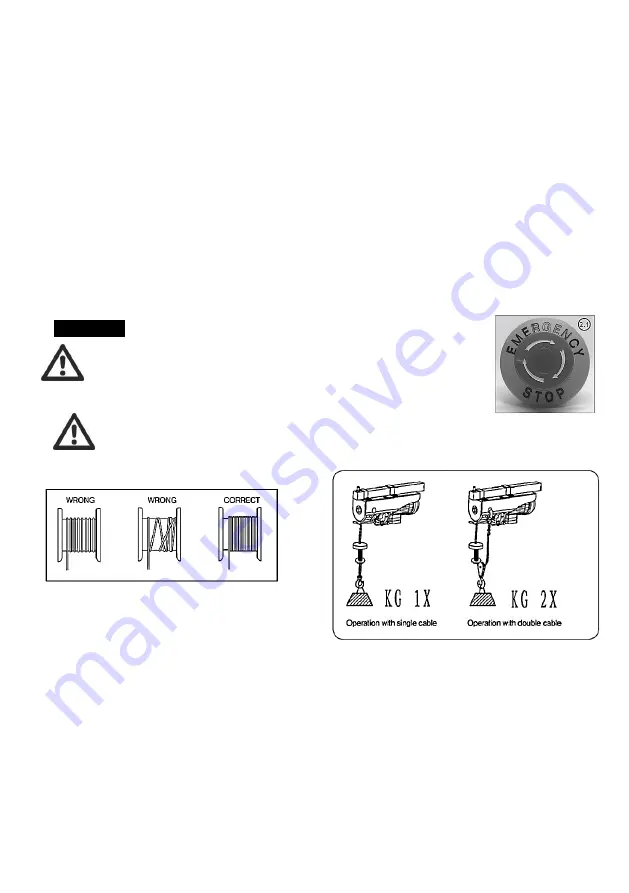
9
•
Perform a no-loading test and check:
o
The flexibility of up/down operating switch
o
The flexibility of up limit bracket
o
The flexibility of down limit bracket to make sure the cut-off circuit when the steel
cable is nearly used up.
o
Any abnormal sounds when start-up operation
Before each use
Check the cable of steel and if it shows areas damaged or reaches 20 hours of operation, replace
it immediately.
Be sure to pull cable into the
square
hole
of
rope drum, and then pull it out from the
round hole. With that
wind
the cable two circles and then pull it to the baffle which is side of cable
drum and fix it.
•
Check the brake disc and every 20 hours of operation, make a dynamic load test weighing
1.1 times rated load (lift a weight of 275 kg with simple cable) to verify the effectiveness of
the brake disc. If the brakes are not working properly, replace broken parts immediately.
•
Check the hook and replace it immediately if it is damaged or shows signs of wear sharp.
•
Make sure there is enough lubricant on parts. Every six months lubricating hook, drum and
bearings.Every time the cable is replace, lubricating the drum bearings.
Operation
WARNING! IN case of any abnormal noise, immediately turn off the
tool by pressing emmergency switch and contact an authorized
service facility for repairs
T
his
machine
is designed for
operating type S3 20
%
-
10 min
(periodic
intermittent
operation), which
means that the device
can
be
operated at
rated load for
2
minutes during
each operating cycle and
must then be
switched
off
for 8.
0
minutes to
cool off.
Operation with single cable
•
Prior to
starting work,
please be
sure
that the
steel cable
is
wound
up
exactly,
layer next to
layer
on
the cable drum. Never unwind the cable completely.
Unwind the
cable only
to the
point that
at
least
3
more layers
are
located
on
the drum. If the red indicator mark is
visible
,
please stop
the
cable winch
immediately
•
The
cable winch
is
operated
using the
operating
panel (10). When
operating
the upper
position
of
the switch, the load is hoisted up.
When operating
the lower position, the load is
lowered
.
Always
stop
the
cable winch prior
to
changing
.
•
Upon lowering a load,
please
remember that the
cable
hoist may
still
unwind
a
few more
centimetres
after
it
was stopped.
Therefore
,
please
stop
in
sufficient
time.
•
Operate the red Emergency Stop button (9) to immediately stop the winch in case of
















